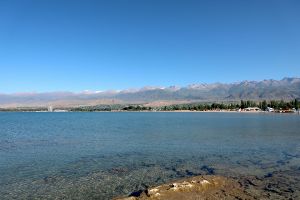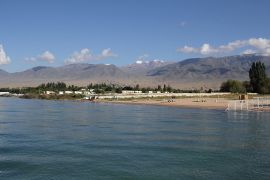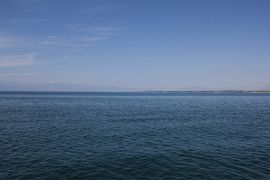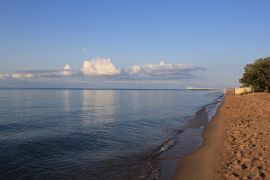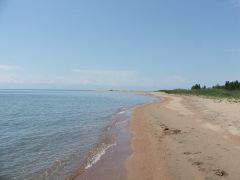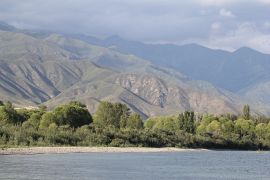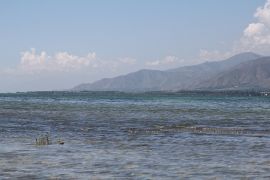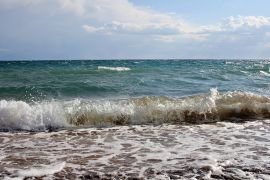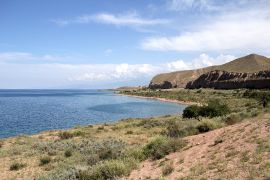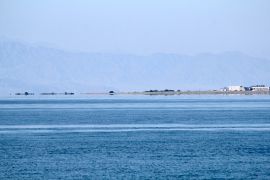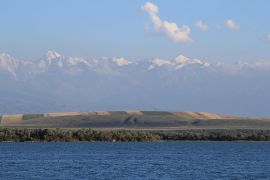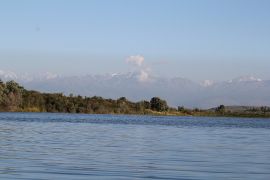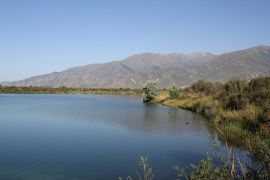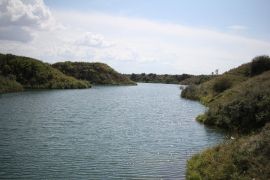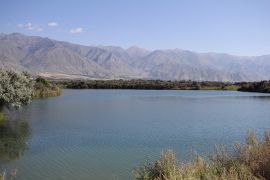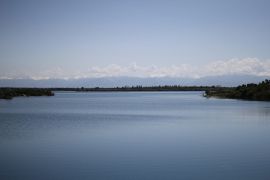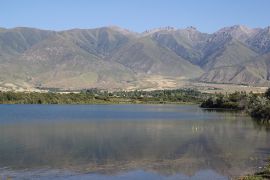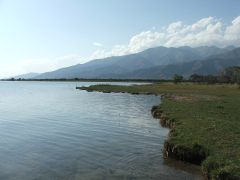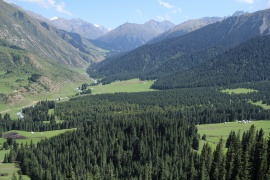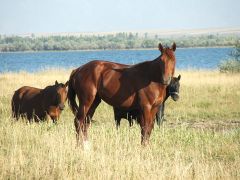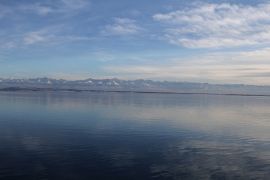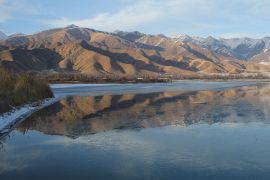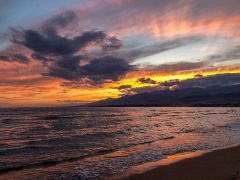Issyk-Kul
Longitude: 77°15′46″
above sea level
Average - 210 meters.
Average (winter): 3°С
Issyk-Kul (Kyrg. Ыссык-Көл - Issyk - means "warm", Kul - means "lake") is a unique high-altitude lake located in the north-eastern part of Kyrgyzstan. It is the largest lake in the republic, and also one of the largest high-mountain reservoirs in the world. The lake has the second rank in terms of the transparency and purity of its water, second only to Lake Baikal.
Feel free to share additional information, post your edits to the article, take part in the discussion of the topic, and ask questions about the location on the talk page.
Geography
Issyk-Kul is located in the northeastern part of Kyrgyzstan in the Issyk-Kul region, between the ridges of the northern part of the Tien Shan - Küngüy-Ala-Too and Terskey Ala-Too, at an altitude of 1,609 meters above sea level. The lake's coast is divided into northern and southern parts; the length of the northern coastline is around 200 km, and the southern one is 250 km, making the total length of the entire coast approximately 450 km.
The maximum length of the lake from west to east is 180 km, and from north to south 56 km. The maximum depth of the lake is 702 meters, and the average depth is 210 meters. The water is brackish, with a salt concentration of 5.9%, which is much lower compared to ocean water. Due to its chemical composition, the water has a significant effect on health.
Climate
There is a mild marine climate at Issyk-Kul due to its geographic location and isolation by mountain systems. The climate is relatively milder than in other parts of the republic in the Issyk-Kul region, as the lake is located much higher than all other regions of Kyrgyzstan. There are around 300 sunny days per year. It is not too hot here because of its mountain ecosystem.
Moderate climate is also characterized by the fact that the lake absorbs the summer heat and the water warms up, so it never freezes even in winter. An exception can be only the eastern part of Issyk-Kul, where winters are usually very cold - in January, the temperature can drop down to -20 °C, and the land is covered with a snow cover and the water in the bays is covered with ice. This is characterized by the proximity of the mountains to the lake as well as the narrowing of Issyk-Kul into numerous bays in this region.
In summer it is very warm, the temperature can rise to 30 °C, but it usually becomes cooler in the evenings. It is quite cold in winter, and the average temperature is -3 to 0 °C. Snow falls in some areas are extremely rare, occurring only 1-2 times in a few years.
The vegetative world of Issyk-Kul is represented by more than three and a half thousand kinds of plants, such as shamur, geranium, forget-me-not, short-toothed iris, edelweiss, bright dandelions, ligulyariya, mountain aster, primrose and aconite. It can also be found such plants as spruce-juniper and rowan-kalin thickets, mountain thuja, greyhound, and sour berries of barberry on the mountains of both the southern and northern coasts.
Tourism
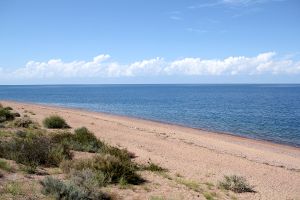
Issyk-Kul attracts tourists from all over the world with its nature, climate, air, water, mountains, beaches, and numerous picturesque places. The lake is one of the best places to relax for people living in Kyrgyzstan, as well as for tourists from different countries. The tourist season begins in June and lasts until the end of September, making it the ideal time to visit. In September, the so-called "velvet" season begins, which can be very convenient for those who do not like hot weather.
There are numerous, different 2-3-4 star hotels and sanatoriums along the coast, allowing you to choose from inexpensive to expensive options. On the beaches, you can take sunbathing, enjoy the fresh sea air, and the pleasant, refreshing water of the lake. There are a lot of tours to different gorges and places for visiting in Issyk-Kul mountains for those who like outdoor activities.
Conventionally, the lake can be divided into three parts: the northern coast, the southern coast, and the eastern part of Issyk-Kul.
North coast
The northern coast of Issyk-Kul stretches for about 200 km, beginning from Balykchy town to Tyup village. There are more hotels and resorts on the northern coast than on the southern part of Issyk-Kul. The biggest tourist centers are Cholpon-Ata and Bostery village, where the infrastructure is more developed.
Along the northern coast, you can visit the picturesque gorges and enjoy the beauty of the local nature. The most popular places to visit are Semenovskoye and Grigorievskoe gorges. It is also recommended to visit the waterfalls of the Ak-Su river and Lake Syuttu-Bulak. There are several hot spring locations along the northern coast that can be visited even in winter.
South coast
The length of the coastline of the southern part of the lake from Balykchy to the capital of Issyk-Kul region, Karakol City, is approximately 220 km. There are far fewer hotels and guest houses here than on the northern coast, however, the interest of tourists, especially among fans of outdoor activities, is high in this region. Among the activities popular among tourists here are bike rides, visiting local mountains, and exploring wild beaches.
The most popular destination along the southern bank of the Karakol is Tamga - Kaji-sai. In these places, the nature of Issyk-Kul differs from the northern shore, offering a diversity of local nature.
Eastern part of the lake
The eastern part of Issyk-Kul is part of the Tyup district and is characterized by the absence of resorts, hotels, and guest houses. It is completely untouched by civilization and is part of the region with its virgin, wild nature. It is notable for its small bays and the proximity of the mountains to the coast, which creates its own microclimate and, on the whole, distinguishes this region from the southern and northern coasts of Issyk-Kul. The transparency of the water in this part of the lake is lower in comparison to the northern and southern coasts due to its predominance of the clay bottom in the local bays and the rapid growth of various algae.
Like in other parts of the lake, it is possible to visit various picturesque gorges overgrown with coniferous forest. The proximity of the mountains to the lake will open up a part of the panorama of the Issyk-Kul region before your eyes.
In winter, this region is also of interest to lovers of alpine skiing, since there is a ski base located not far from the capital of the Issyk-Kul region - Karakol city.
Resorts
There are many resorts, hotels, and guest houses along the coast of Issyk-Kul. Most of them are located on the north coast; in the southern part of the lake, there are fewer resort places. The center of resorts is at Cholpon-Ata and Bosteri. You can find any level of hotels and boarding houses, from the most simple, budget private cottages to very comfortable five-star hotels.
Summer is the main period for any activities at the lake, but you can also come to the sanatorium in winter. There is also the possibility to come to ski on the slopes of the ski resort in Karakol.
Interesting places
- The petroglyphs of Cholpon-Ata are a monument of rock carvings from various eras and cultures, which are quite numerous in Kyrgyzstan. It is a large tract of thousands of stones on 42 hectares of land, located near the main resort of Issyk-Kul - the town of Cholpon-Ata. The drawings with which the stones are covered depict animals, scenes of hunting, wars and festivities. The dates of the drawings range from the beginning of 2000 BC to the 7th century AD. Scientists have not yet identified the purpose of such a large collection of stones covered with drawings in one place;
- Museum "Rukh Ordo" is located in the town of Cholpon-Ata on the shore of Lake Issyk-Kul in Kyrgyzstan. This is a whole spiritual and cultural center that embodies the stories, legends and myths associated with the lake, as well as with world religions. The name "Rukh Ordo" is translated as "Blessed City", and according to the idea of the founder of the museum Tashkul Kereksizov, its uniqueness lies in the unification of the five major religions of the world;
- Salt lake Tuzkol is the saltiest mountain lake in Kyrgyzstan. It is located on the southern shore of Lake Issyk-Kul, 73 km from Balykchi, 1 km from the coastline, in the mountain frame of Terskey Ala-Too (1609 m above sea level);
- Jety-Oguz Gorge (from the Kyrgyz language meaning "Seven Bulls") is a picturesque gorge located in Kyrgyzstan, on the southern coast of Lake Issyk-Kul, 17 km west of the administrative center of Karakol. The name has a symbolic meaning, which conditionally characterizes seven rocky cliffs in the mountain range at the foot of the gorge. However, now there are more rocks due to natural processes. In the gorge there is also a waterfall Maiden's braids, which can be reached quite quickly on foot. Around Issyk-Kul there are dozens of different gorges, canyons, waterfalls, the stay in which leaves the most positive emotions.
How to get to the lake
One of the major transport hubs in Kyrgyzstan, connecting the roads with Issyk-Kul through the Boom gorge, is the capital of the Republic: Bishkek. There are numerous buses and taxis from the capital to Issyk-Kul, with prices varying depending on the type of transport.
The map shows the routes along the northern and southern shores of the lake. The route from Bishkek to Karakol along the northern coast is 400 km, and along the southern coast is 390 km, taking approximately 5.5-6 hours. The total length of the path around Issyk-Kul is 450 km. In 2015, a new two-lane road was built from the capital to Balykchy, located in the western part of Issyk-Kul.
In 2017, a new road was built from Balykchy to Cholpon-Ata, improving traffic flow towards the lake and back, and reducing the number of accidents along the highway. The quality of the roadway along the northern coast to Cholpon-Ata and the southern coast is satisfactory.
Direct flights to Bishkek are offered by companies such as Aeroflot, S7, Turkish Airlines, and others.
Photo gallery
- Issyk-Kul Photos
-
View of the beach near Cholpon-Ata
-
One of the beaches of resorts at Issyk-Kul
-
The general landscape of Issyk-Kul
-
Morning at Issyk-Kul
-
Central part of the lake
-
Wild beach in the north-east of the lake
-
View to the north-east coast
-
Issyk-Kul Waves
-
On the south coast
-
The central part of the southern coast
-
In the south of Issyk-Kul
-
Central part of the lake
-
South-east coast
-
Bay in the eastern part of the lake
-
Pure nature of the eastern part of the lake
-
Bays in the East of Issyk-Kul
-
Issyk-Kul Bay of Frunze village
-
View to the southern shore of the lake
-
Wild, pure places in the east
-
View from the mountains of the eastern part of Issyk-Kul
-
Mountains in the north-eastern part of the lake
-
View to the west, towards Cholpon-Ata
-
Panoramic view of the local gorge (Djety-Oguz)
-
Grazing horses on the shore of the lake
-
View of bays from the northern slope of the mountains
-
Winter Issyk-Kul
-
Winter in the north-eastern part of the lake
-
Sunset at Issyk-Kul
Interesting facts
- The main part of Issyk-Kul does not freeze in the winter months due to the fact that during summer the water warms up fairly well, except for the eastern part of the lake, as there are a large number of bays and its close proximity to the mountains.
- The water level drops and then increases by 10-20 meters over a long period of time, approximately one century. At present, the water level is increasing.
- The lake has more than 80 mountain rivers that flow into Issyk-Kul, while there is no river that has its source from the lake. There are the ruins of the ancient city of Chigu at the bottom of Issyk-Kul.
- There is a so-called "dead sea" on the southern coast, near the village of Kara-Koo.
- An intriguing version is that this remote lake was the last resting place of evangelist St Matthew, one of the 12 disciples of Jesus, and the find may support a theory that an Armenian monastery once existed here, at which his relics were supposedly buried.[1]
- There are ancient artifacts of people (ruins of ancient settlements and barrows) who have been living in this region for 1000-2000 years.
Final note
Holidays in Issyk-Kul will leave an unforgettable impression for both lovers of passive, comfortable rest, and for those who prefer active rest and appreciate the beauty of pristine nature. For any additional edits to the article or questions regarding tourism in Issyk-Kul, please leave them in a specially created discussion page.


